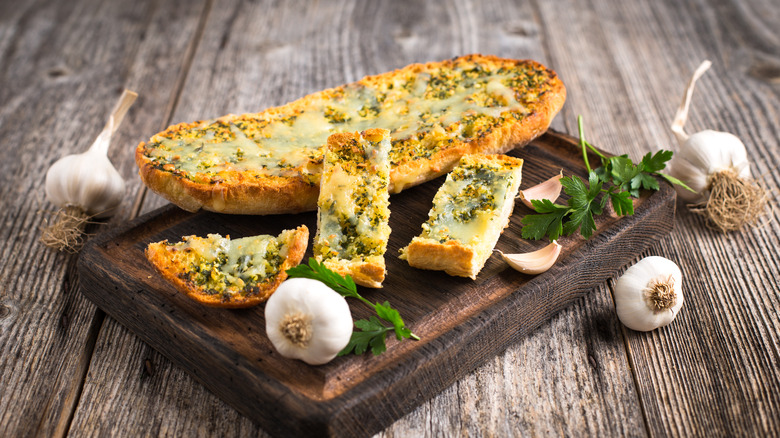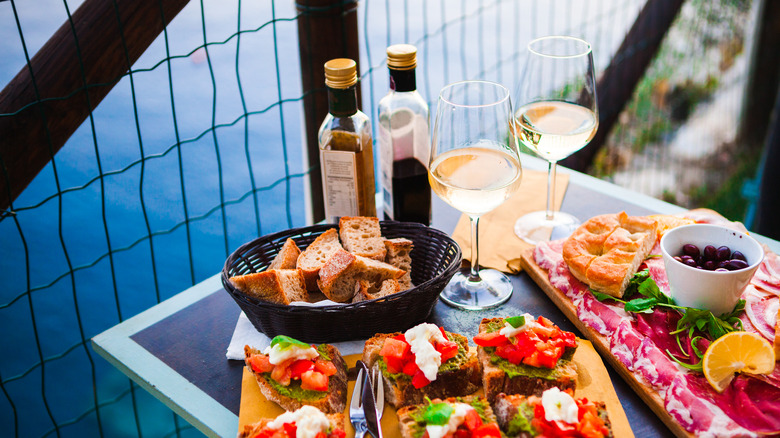When envisioning a meal in Italy, many might dream of a warm, crusty loaf of garlic bread accompanying a hearty plate of spaghetti, perfectly complementing the rich, tomato-based sauce. This image, however, is where fantasy diverges sharply from reality. Garlic bread, as known and loved by many outside of Italy, actually doesn’t exist in the traditional Italian kitchen. Ordering garlic bread is one of those things tourists should never do when visiting Italy — it will earn some confused looks from the waiter and stamp you with a clear “tourist” label.
Garlic bread typically involves a baguette or similar loaf, split open and slathered with a generous mix of butter, garlic, and herbs like oregano, then broiled to perfection. Sometimes, it is topped with cheese, such as mozzarella or Parmesan. It’s been a staple in Italian-American cuisine since the 1950s, readily found on menus and even supermarket freezer aisles across the United States and other countries. Despite being ubiquitous (and unlimited) in every Olive Garden, garlic bread is neither of those things in Italian dining.
Its absence in Italian restaurants and homes starkly represents the culinary differences that have evolved with Italian cuisine abroad. According to a 2021 survey conducted by YouGov, 48% of Italians considered having garlic bread with a pasta meal unacceptable. You will, however, find garlic bread in Italian restaurants that cater to tourists, especially in major cities like Rome, Venice, and Milan. But the garlic bread found there is a false pretender of the original ancestor: bruschetta.
Garlic bread vs. bruschetta

Pronounced like “bru-sketta,” bruschetta is a staple dish with mysterious origins: Some believe it originated in the 15th century in Central Italy, while others consider it to be much older, dating back to ancient Rome (when olive growers would use bread to sample the first fresh-pressed batch). The basic recipe calls for grilled Italian bread rubbed with garlic, sprinkled with salt, pepper, and tomatoes, drizzled with olive oil, and garnished with basil. Variations may include mozzarella, onion, cured meats, and other toppings.
So, how did garlic bread evolve from this historic dish? Between 1880 and 1924, more than 4 million Italians immigrated to the U.S., with many more following in the decades after. Italians had to adapt to a new life, new cuisine, and new ingredients. Olive oil and tomatoes, foundational to bruschetta and Italian cooking, were scarce back then. Butter, found abundantly, was the next best thing. Thus, garlic bread was born — the Italian-American version of bruschetta. Another close relative is the Tuscan appetizer “fettunta”: a grilled slice of garlic-rubbed bread drizzled with olive oil.
Italian culinary philosophy is rooted in the concept of “cucina povera,” or “peasant cooking,” which emphasizes simplicity, seasonality, and making the most of local ingredients. This manifests in a minimalistic yet flavorful preparation of dishes, where the quality of the ingredients are the focus without the need for heavy sauces or excessive garnishes. Yes, bread and garlic do play a significant role in Italian cooking, but not in the amalgamation known as garlic bread.
What to order instead

The expectation of finding garlic bread on Italian menus is a clear example of how Italian-American cuisine has diverged from its roots, adapting to local tastes and ingredients. This has given rise to a new culinary tradition that, while Italian in inspiration, is uniquely American in execution. Other dishes, such as spaghetti and meatballs, chicken parmesan, shrimp scampi, and, indeed, garlic bread, are beloved in the U.S. but would be considered untraditional or even ridiculous in Italy.
For those eager to dive into authentic Italian dining, it’s essential to embrace local eating habits and traditions. Opting for regional specialties and asking locals for recommendations can lead to a more genuine and enriching culinary experience. It’s also a fantastic opportunity to discover dishes that might never make it onto the menus of restaurants anywhere outside of Italy, such as ribollita from Tuscany, ossobuco from Lombardy, or caponata from Sicily.
Familiar foods can be comforting, especially when traveling far from your home turf. However, venturing outside of one’s culinary comfort zone is a rewarding aspect of exploring new cultures. Instead of seeking out the blasphemous garlic bread, why not try pane all’Olio (bread made with olive oil) or focaccia al rosmarino (rosemary focaccia)? Or, of course, the original bruschetta or fettunta. These dishes will offer a taste of genuine Italian bread traditions without the faux pas of ordering a non-existent staple. Plus, you’ll eat and look like a local when traveling in Italy. Buon appetito!

